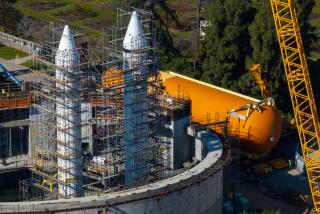Official Was Never Told How Cold Booster Got : Expert Lays Blast to Chilling of Seals
- Share via
KENNEDY SPACE CENTER, Fla. — A breeze wafting over a tank full of frigid fuel was apparently enough to lower temperatures on the space shuttle Challenger’s right solid rocket booster to 7 degrees on the morning of the launching, a Caltech physicist investigating the shuttle’s explosion said Tuesday.
Richard P. Feynman, a member of a presidential commission investigating the Jan. 28 disaster, said the low temperature “definitely affected” the ability of the booster’s synthetic rubber seals to contain the rocket’s flaming gases and probably led to the ultimate explosion.
‘I’d Be Worrying’
“Even if it was 30 degrees, I’d be worrying. To find it even lower must make it more certain that there was something bad with the rubber. The rubber isn’t functioning right at those temperatures,” he said in an interview.
Feynman said he has confirmed that “unusually low” infrared temperature readings taken by an ice inspection team three to five hours before the launching were accurate, despite NASA officials’ questions about the readings.
NASA Administrator William R. Graham told a Senate subcommittee Tuesday that agency officials believe the readings could have a “substantial error.” Feynman said his meetings with Kennedy Space Center engineers Tuesday convinced him otherwise.
Although he conceded that infrared measurements are not always precise and that the 7-degree reading and another spot reading on the booster of 9 degrees Fahrenheit were “unusually low, by perhaps 11 or 12 degrees,” Feynman said that “reasonable measurements in other places (on the shuttle) were made,” so it looks like the readings on the booster were truly abnormally low.
For instance, the temperature on the left rocket booster was within a normal range of about 24 degrees, he said.
A key finding was a temperature measurement on the outside of the external fuel tank of minus 8 degrees, Feynman said.
The tank, filled with half a million gallons of supercooled liquid hydrogen and liquid oxygen, is insulated well enough so that outside temperatures are normally not unusually low, NASA spokesman Jim Mizell, a former engineer, said.
“It’s usually the same as ambient (temperature),” Mizell said. “The only time you have anything other than ambient is a little bit of frost. It’s a very well insulated vehicle.”
Fuel Leak Discounted
Some aerospace specialists have speculated that a slow leak of liquid hydrogen from the tank could have caused temperatures outside to plummet. But Feynman said he had not seen evidence of a fuel leak, thus leaving unexplained why the skin of the massive tank became so cold.
However, NASA officials did provide information showing that a slight breeze was blowing across the frigid fuel tank toward the right rocket booster, explaining why its temperature was so much lower than that of the left.
“In the middle (of the shuttle assembly) is the tank, and the air comes down like the air past an ice cream bar,” Feynman explained.
“As it falls down, it is cooled. Meanwhile, there was a slight wind in the direction toward the right-hand booster . . . . When you have air like that and a small breeze, it’s no miracle that (the temperature on) one side should be lower than the other.”
“I do think the fact that the temperature was so low that night, and now I’ve discovered the booster itself was even lower, definitely affects the action of an important part of the machinery.
“The material of the O-ring was expected to be resilient, but, at temperatures even as low as freezing, it isn’t resilient to speak of in any reasonable time, that is, a few seconds (as the rocket builds to full pressure). The fact that it (the seal) is going to (respond) slower than that, just makes (the failure of the seal) more certain.”
Attention focused on the two rubbery seals as the most likely cause of the explosion after NASA released photos of the Challenger launching that show a puff of black smoke, and later a plume of fiery gases, apparently emanating from a joint between the right booster’s lower segments.
NASA officials have said they launched the shuttle with the belief that, even should one seal fail as the booster swelled rapidly to 3.3 million pounds of thrust on ignition, the other would hold.
Graham refused Tuesday to provide detailed answers to committee members’ questions about whether engineers from Morton Thiokol Inc., manufacturer of the boosters, expressed doubts about proceeding with the launching because of the 24-degree ambient temperatures the night before.
“I cannot today give a clear, comprehensive and definitive answer to that question,” Graham told the committee.
Tom Russell, a spokesman for Morton Thiokol, said in an interview Tuesday that company engineers “initially expressed some concern, and said we should only launch in a range of temperatures which we had previously experienced.” Those concerns were relayed to NASA officials in telephone conversations the night before the launching, he said.
“At a later point in time (that night), after considering other facts, we said we were in agreement for a launch based upon the anticipated temperatures of the next day,” Russell said.
The 38-degree temperature at the time of the launching was 13 degrees colder than on any previous launching day.
More to Read
Sign up for Essential California
The most important California stories and recommendations in your inbox every morning.
You may occasionally receive promotional content from the Los Angeles Times.













